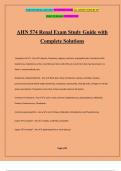©GRACEAMELIA 2024/2025 ACADEMIC YEAR. ALL RIGHTS RESERVED
FIRST PUBLISH OCTOBER 2024
AHN 574 Renal Exam Study Guide with
Complete Solutions
Symptoms of UTI - Ans:✔✔-dysuria, frequency, urgency, nocturia, suprapubic pain, hematuria with
bacteriuria, malodorous urine, incontinence, fever and chills are uncommon but may be present, no
flank or costovertebral pain.
Symptoms of pyelonephritis - Ans:✔✔-flank pain, fever, hematuria, nausea, vomiting, malaise,
pronounced costovertebral angle tenderness, tachypnea, tachycardia, shaking chills, changes in mental
status esp elderly, if symptoms more than 3 days consider abscess formation
Common UTI bacteria - Ans:✔✔-E.coli is most common, Staphylococcus Saprophyticus, Klebsiella,
Proteus, Enterococcus, Citrobacter
Common pyelonephritis - Ans:✔✔-E.coli, Proteus, Klebsiella, Enterobacter, and Pseudomonas
Lower UTIs include? - Ans:✔✔-cystitis, urethritis, prostatitis
Upper UTIs Include? - Ans:✔✔-pyelonephritis or renal abscess
Page 1/43
, ©GRACEAMELIA 2024/2025 ACADEMIC YEAR. ALL RIGHTS RESERVED
FIRST PUBLISH OCTOBER 2024
treatment options • Uncomplicated Lower UTIs - Ans:✔✔-A 3-day course is preferred over a single dose
regimen due to high relapse rates o options: Cephalexin, nitrofurantin (5 days), trimethoprim-
sulfamethoxazole
treatment options Uncomplicated Upper UTIs - Ans:✔✔-Patients with mild to moderate illness who are
able to take oral medications can be safely treated as outpatients with Bactrim or Cipro for 7 days
Patients with more severe illness, those who are nauseated or vomiting, and pregnant patients should
be treated initially with parenteral therapy.
May use third-generation cephalosporins, fluoroquinolones, or aminoglycosides. o Patients of advanced
age or with toxemia should be hospitalized and initiated on aminoglycoside therapy
treatment for pyelonephritis - Ans:✔✔-Inpatient- ampicillin and an aminoglycoside though you will also
see a third generation cephalasporin used IV
Outpatient: Cipro, levofloxacin, trimethoprim-sulfamethaxazole
Do NOT use this antibiotic for pyelonephritis - Ans:✔✔-Nitrofurantoin
When do Men need further urologic work up from uti - Ans:✔✔-when treatment fails, in the event of
recurrence, or when pyelonephritis occurs
Page 2/43
, ©GRACEAMELIA 2024/2025 ACADEMIC YEAR. ALL RIGHTS RESERVED
FIRST PUBLISH OCTOBER 2024
Patients who fail initial empiric treatment in 48 hours - Ans:✔✔-antimicrobial therapy should be changed
to treat the pathogen detected by the initial urine culture and the presence of an anatomic abnormality
should be considered
Treatment for urinary retentino - Ans:✔✔-Phenazopyridine hydrocholride (Pyridium) 200mg PO TID for
48 hours
Avoid these antibiotics during pregnancy and near delivery - Ans:✔✔-Quinolones and Sulfonamides
Antibiotic of choice for pregnancy - Ans:✔✔-Cephalexin
prophylactic treatment for uti may be used for who? - Ans:✔✔-those with frequent reinfections (3 or
more per year)
prophylactic UTI treatment includes - Ans:✔✔-TMP/SMX, 80mg/400mg or cephalexin 250mg after
coitus.
TMP/SMX, 40mg/200mg QD or QOD for recurrences unrelated to coitus.
additional work up for pyelonephritis includes - Ans:✔✔-failure to respond within 48 hours warrants
imaging (CT or ultrasound) to exclude complicating factors that may require intervention.
Indications for IVP - Ans:✔✔-The intravenous pyelogram (IVP) had been the standard imaging procedure
for evaluating the urinary tract because it provides an assessment of the kidneys, ureters, and bladder.
Page 3/43
, ©GRACEAMELIA 2024/2025 ACADEMIC YEAR. ALL RIGHTS RESERVED
FIRST PUBLISH OCTOBER 2024
Useful in diagnosing certain disorders such as medullary sponge kidney and papillary necrosis
Contraindications for IVP - Ans:✔✔-An IVP necessitates the injection of contrast, however, and is
relatively contraindicated in patients at increased risk for AKI (eg, diabetes mellitus with serum
creatinine greater than 2 mg/dL, severe volume depletion, or prerenal azotemia), CKD, and plasma cell
myeloma.
Ultrasonography often replaces IVP to avoid dye administration, and helical CT scanning often replaces
IVP for stone evaluation
If hematuria is present - Ans:✔✔-need cystoscopy and excretory urography
AKI is defined as - Ans:✔✔-absolute increase in serum creatinine by 0.3mg/dL or more within 48 hours
or a relative increase of > or = 1.5 times baseline that is known or presumed to have occurred within 7
days
Causes of Prerenal AKI - Ans:✔✔-Hypovolemia - vomiting, diarrhea, hyperglycemia with polyuria
Decreased cardiac output/Decreased effective circulating volume - CHF, cardiogenic shock, pulmonary
embolism, pericardial tamponade, arrhythmias, valvular disease, liver failure
Page 4/43




